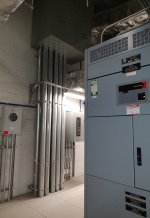Hi!
I have a service that terminates in a SEB in NYC. I am planning to tap the SEB and run it to a new CT/Disconnect.
I have an electrician saying that the feeder needs to be encased in concrete. I have not seen this ever done.
If this is needed, what code section covers this? I did my research but couldn't find much.
Thank you!
I have a service that terminates in a SEB in NYC. I am planning to tap the SEB and run it to a new CT/Disconnect.
I have an electrician saying that the feeder needs to be encased in concrete. I have not seen this ever done.
If this is needed, what code section covers this? I did my research but couldn't find much.
Thank you!


